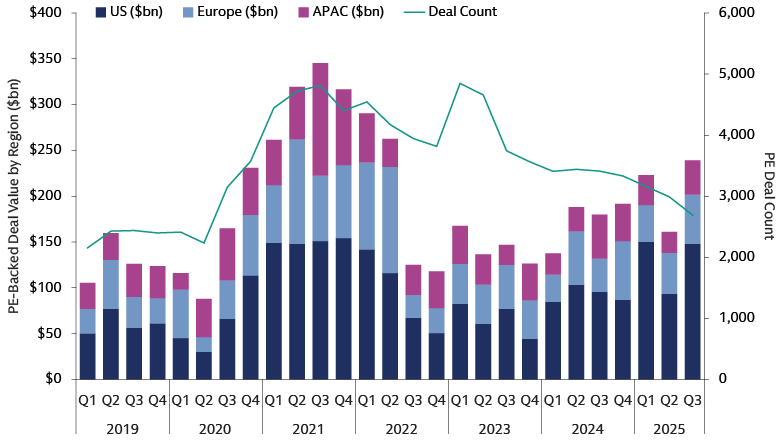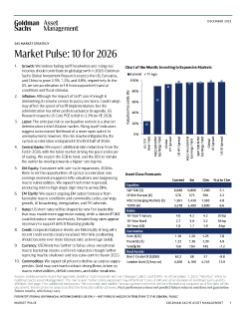Market Pulse: 10 for 2026
We believe fading tariff headwinds and rising real incomes should contribute to global growth in 2026. Goldman Sachs Global Investment Research expects the US, Euro area, and China to grow 2.5%, 1.2%, and 4.8%, respectively. In the US, we see acceleration in 1H from supportive financial conditions and fiscal stimulus.
Although the impact of tariff pass-through is diminishing, it remains central to policy decisions. Court rulings may affect the speed of tariff implementation, but the administration has other paths to advance its agenda. GS Research expects US Core PCE to fall to 2.3% by YE 2026.
The principal risk to our baseline outlook is a sharper deterioration in the US labor market. Rising layoff indicators suggest an increased likelihood of a more rapid uptick in unemployment; however, this risk may be mitigated by the cyclical acceleration anticipated in the first half of 2026.
We expect additional rate reductions from the Fed in 2026, with the labor market driving the pace and scale of easing. We expect the ECB to hold, and the BOJ to remain the outlier by moving towards a higher rate regime.
Consistent with late-cycle expansions, 2026 is likely to set the opportunities of cyclical acceleration and earnings momentum against lofty valuations and burgeoning macro vulnerabilities. We expect the former to prevail, producing mid-to-high single digit returns across DMs.
We expect ongoing EM outperformance from favorable macro conditions and commodity cycles, earnings growth, AI broadening, deregulation, and FX tailwinds.
US short rates will be shaped by new Fed leadership that may enable more aggressive easing, while a divided FOMC could introduce more uncertainty. Elevated long rates appear necessary to support deficit financing globally.
Corporate balance sheets are historically strong with recent credit events clearly localized. We think positioning should become ever more idiosyncratic as leverage builds.
USD likely has further to fall as a less-exceptional macro backdrop erodes a still-rich valuation, though further repricing may be shallower and less euro-centric than in 2025.
We expect oil prices to decline as surplus supply persists. Gold may continue to attract strong flows, driven by macro vulnerabilities, deficit concerns, and dollar weakness.

Source: MSCI and Goldman Sachs Asset Management. As of October 24, 2025. Valuation percentiles are since 2005, earliest common inception.

Asset Class Forecasts: Price targets of major asset classes are provided by Goldman Sachs Global Investment Research. Source: “Global Equities Rebound” and “MSCI EM rebounded 3% w/w, led by Brazil & Taiwan among majors;” As of December 1, 2025.
Three Key Themes
Our overall outlook is constructive for the year ahead, yet risks abound. Stronger than expected growth or inflation could disrupt the path for Fed cuts. Earnings, which underpin our global equity views, could disappoint. Geopolitical and cyclical shocks are real possibilities. Valuations are high across almost all markets, inviting episodic volatility and periodic pullbacks. With all this in mind, we are approaching 2026 through three key themes across equities, fixed income, and alternatives.

Source: Goldman Sachs Global Investment Research. As of November 30, 2025. Chart shows forecasted annualized total returns in local currency terms over the next 10 years for EM, Asia Pacific ex Japan (APxJ), Japan, Europe, US, and global equities. EM is represented by MSCI EM, Asia Pacific ex Japan (APxJ) by MSCI APxJ, Japan by MSCI Japan, Europe by STOXX 600, US by S&P 500, and global equities by MSCI AC World. The chart also displays the expected contribution of dividends, buybacks, valuations, and earnings to total returns.
We see attractive global equity returns driven by economic and earnings growth, improved productivity and profitability, and strong shareholder returns. In particular, we expect higher nominal GDP growth and structural reforms to favor EM, while AI’s long-term benefits should be more broad-based beyond US tech. We remain optimistic on US equities, but high levels of concentration and full valuations underscore the need for diversification.

Source: Bloomberg and Goldman Sachs Asset Management. As of October 31, 2025. : Chart shows the current yield to worst and historical average yield since 2000, or earliest available data. Global Agg refers to the Bloomberg Global Aggregate Total Return Index. US Securitized refers to the Bloomberg US Securitized: MBS/ABS/CMBS and Covered TR Index. US IG refers to the Bloomberg US Corporate Bond Index. EMD refers to the Bloomberg EM USD Aggregate Index.
With global rates moving lower in 2026, investors may need to be more dynamic in finding income in their portfolios. We see pockets of value in securitized, high yield, and leveraged loan markets (both public and private), where credit fundamentals are relatively healthy and spreads are more attractive. Additionally, EM debt could remain a strong source of alpha given improving growth outlooks and the continued resilience of EM sovereign and corporate issuers.

Source: Refinitiv and Goldman Sachs Asset Management. As of June 30, 2025. Chart shows global private equity (PE) deal activity and deal count. A traditional 60/40 portfolio refers to an investment strategy that allocates 60% of assets to equities and 40% to fixed-income investments.
Private markets can complement a traditional 60/40 portfolio by accessing secular themes on longer time horizons with better risk-adjusted return potential. We believe a more constructive backdrop for capital markets activity in 2026 may lead to renewed opportunities in private equity; private credit still offers attractive yields, though rigorous underwriting will be key to navigate potential pressure points; and we see emerging opportunities in infrastructure driven by AI and increased power demand.
“We/Our” refers to Goldman Sachs Asset Management. The economic and market forecasts presented herein are for informational purposes as of the date of this document. There is no guarantee that objectives will be met. There can be no assurance that forecasts will be achieved. Diversification does not protect an investor from market risk and does not ensure a profit. Please see additional disclosures at the end of this document. Past performance does not predict future returns and does not guarantee future results, which may vary.

